[Esp/Eng] Acorazado Bismarck "Bestia Nazi" / Battleship Bismarck "Nazi Beast".

Bienvenid@
Hola mi querido o querida historiador(a) espero que estés pasando un gran día , pues hoy les traigo la historia de un gran acorazado llamado "Bismarck" un barco que tiene mucha historia consigo , sin más que decir comencemos:
Acorazado Bismarck
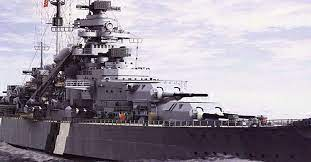
Este gran acorazado perteneciente a la Alemania Nazi fue el símbolo y orgullo de la armada de la Alemania de Adolf Hitler (Kriegsmarine), fue el primer acorazado de la clase "Bismarck".
El acorazado Bismarck recibe su nombre al gran canciller Otto Von Bismarck (canciller promotor de la unificación de Alemania en 1987).
Dicho acorazado comenzó su construcción en julio de 1936 y fue puesto a flote en 1939 , durante unos meses se le realizaron varias pruebas , como en el caso de su velocidad máxima , maniobrabilidad del buque y estabilidad de tiro.

Cuando se realizaron estas pruebas se pudo comprobar que había un fallo en el diseño , en el cual consistía en la maniobrabilidad del buque , pues no giraba bien y a duras penas podía mantener el rumbo.
Recibió pruebas de acondicionamiento en la bahía de Kiel , cabo de Arkona y en el golfo de Danzig, tras varios meses de pruebas el acorazado fue dado como plataforma de tiro estable e incorporado a la Kriegsmarine en 1940 , junto con su gemelo el Tirpitz.
Operación Rheinübung
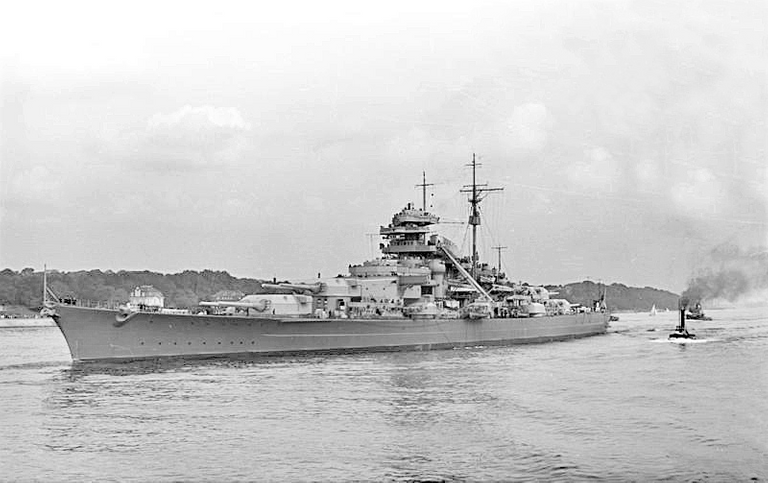
El 5 de mayo Adolf Hitler iría a visitar a el acorazado Bismarck y a su gemelo el Tirpitz con Wilhelm Keitel , donde discutiría los planes de la siguiente misión con Lütjens.
El día 16 de mayo Lütjens pasó un reporte al alto mando donde decía que los buques Bismrack y Prinz Eugen estaba operativos y listos para zarpar, ya con eso dicho se ordenó que dichos barcos encabezaran la operación Rheinübung , que sería para dificultar lanavegación de barcos mercantes y de la marina de los Aliados hacia Europa.
El Bismarck y el Prinz Eugen serían escoltados por 3 destructores y varios dragaminas en su trayecto, el Bismarck para esa operación llevaba un aproximado de 2221 hombres a bordo que se dividieron en 12 divisiones de entre 200 y 300 hombres.
El capitán del Bismarck era Ernst Lindemann , fue el único capitán del Bismarck ,el día que zapó al encuentro con el Prinz Eugen , desde lo altavoces del buque de guerra le informó a toda la tripulación sobre la misión.
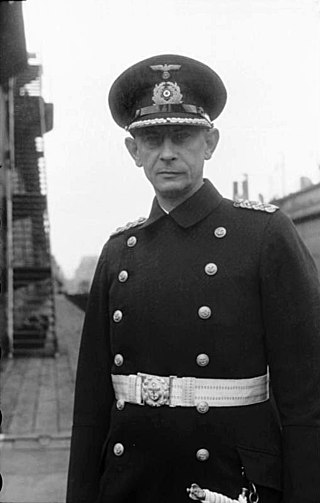
En el transcurso del día una escudrilla de unos 12 aviones suecos avistarían al Bismarck e informarían a la Armada Real de Gran Bretaña de la ubicación del Bismarck y su rumbo.
el día 20 el Prinz Eugen y el Bismarck estaban llegando a costas noruegas y se separarían de los dragaminas y destructores escoltas , ya de allí en adelante sabían que estaban solos,horas después el Prinz Eugen detectaría señales de radio que fueron enviadas a pilotos de la RAF (Royal Air Force) a buscar a 2 acorazados y 3 destructores, en las costas de Noruega.
Para el día siguiente una aeronave de reconocimiento británica tomaría fotos de los acorazados, la información que recolectó fue enviada al almirante inglés Jhon Tovey , el mismo ordenaría a los acorazados HMS Hood y el HMS Prince of Wales, junto con 6 destructores reforzar la fuerza que patrullaba el estrecho de Dinamarca.
En su estancia en Noruega el Prinz Eugen recargó combustible , pero el Bismarck no, horas después de partir de Bergen ya estaban en mar abierto en dirección a el océano ártico, más tarde los 2 acorazados cambiaron su rumbo hacia el estrecho de Dinamarca , donde fueron interceptados por un buque ingles el HMS Suffolk , buque que revelaría su posición y los perseguiría desde una distancia segura.
Más tarde el HMS Nortfolk se uniría junto al HMS Suffolk , pero el Nortfolk cometió un error al acercarse mucho los acorazados alemanes y Lütjens ordenó a los acorzados disparar al buque inglés , el HMS Nortfolk recibió 3 impactos graves a su cubierta , pero dicho barco lanzaría una cortina de humo para escaparse y refugiarse en un banco de niebla.
Batalla del estrecho de Dinamarca
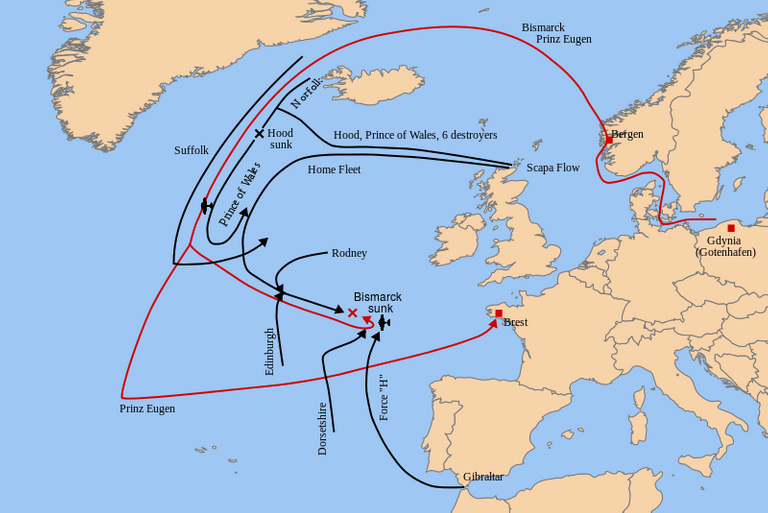
A mediados de las 5 de la tarde personal de los acorazados alemanes vieron humo procedentes del Price of Wales y el Hood , buques que estaban el mando de el vicealmirante Lancelot Holland,inmediatamente Lütjens ordenó a los tripulantes que tomaran sus puestos de combate.
Cuando las distancias se acortaron el Prices of Wales y el Hood procedieron a disparar su cañones , pero había algo de lo que no estaban enterados , y es que el Hood pensaba que le disparaba era al acorazado Bismarck y en realidad le estaba disparando al Prinz Eugen , mientras tanto el Prince of Wales disparaba el Bismarck.
Mientras el acorzado Bismarck estaba bajo ataque , Lütjens se había quedado mudo frente a las peticiones del primer oficial artillería que le pidió un par de veces permiso para devolver el fuego, minutos Lindemann dijo "no dejaré que a mi nave se le dispare bajo mi culo" y le pidió permiso a Lütjens y este cedió.
Tras varias maniobras el Prinz Eugen y el Bismarck estaban disparando al Hood , varios impactos había recibido el Hood pero el que le dio la estocada final fue uno de los proyectiles de la 5ta salva del Bismarck que hizo estallar una santabárbara de polvora y posteriormente causaría un incendio en el mástil y haría que el Hood se empezara a hundir de forma rápida , en menos de 3 minutos el Hood se hundió con una tripulación de 1400 hombres.
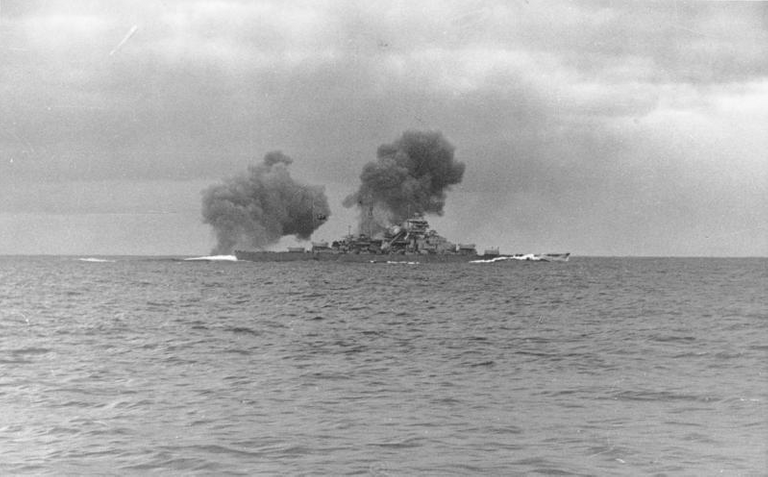
Con el Hood hundido los buques alemanes procedieron a concentrar su fuego en el Prince of Wales que recibiría varias cañonazos fuertes.
El PRince of Wales se retiraría con 2 cañones funcionales de los 10 que tenía , cuando se dio la información a los cuarteles de Gran bretaña , procedieron ordenar a un gran flota de barcos la busqueda frenética del Bismarck , pues el HMS Hood era un buque insignia de la armada británica.Tras varios enfrentamientos el Bismarck había quedado inmaniobrable ya que uno de sus timones los dañó un torpedo, cuando torpederos provenientes del portaaviones Ark Royal los interceptaron.
Con el Bismarck inmovilizado una gran flota de buques De Gran Bretaña fueron a acabar lo comenzado , Lindemann había dicho "el acorazado esta totalmente inmovilizado , lucharemos hasta las última salva , larga vida al Führer".
Cuando los buques ingleses los interceptaron , el Bismarck recibía varios impactos desde todos lados , ya sin nada que hacer y un proyectil mató a Lindemann y a los otros oficiales , para evitar que la tecnología cayera en manos inglesas , los tripulantes decidieron echar el acorazado a pique y así fue , el 27 de mayo de 1941 el gran acorazado Bismarck se hundió con 2200 tripulantes.
Más información:
Historia del acorazado Bismarck
Gracias por leer , si te gustó comparte para que más personas disfruten de este contenido , sin más que decir nos vemos en otra historia <3.


Welcome
Hello my dear historian, I hope you are having a great day, today I bring you the history of a great battleship called "Bismarck" a ship that has a lot of history, without more to say let's begin:
Battleship Bismarck

This great battleship belonging to Nazi Germany was the symbol and pride of the navy of Adolf Hitler's Germany (Kriegsmarine), it was the first battleship of the "Bismarck" class.
The battleship Bismarck is named after the great Chancellor Otto Von Bismarck (Chancellor promoter of the unification of Germany in 1987).
The battleship began construction in July 1936 and was launched in 1939, during a few months she underwent several tests, as in the case of its maximum speed, maneuverability of the ship and stability of shot.

When these tests were carried out it was found that there was a flaw in the design, which consisted in the maneuverability of the ship, as it did not turn well and could hardly keep the course.
She received trials in the Bay of Kiel, Cape Arkona and in the Gulf of Danzig, after several months of testing the battleship was given as a stable firing platform and incorporated into the Kriegsmarine in 1940, along with her sister ship the Tirpitz.
Operation Rheinübung

On May 5, Adolf Hitler would go to visit the battleship Bismarck and her sister ship Tirpitz with Wilhelm Keitel, where he would discuss the plans for the next mission with Lütjens.
On May 16, Lütjens passed a report to the high command where he said that the ships Bismrack and Prinz Eugen were operational and ready to sail, and with that said it was ordered that these ships would lead the Rheinübung operation, which would be to hinder the navigation of merchant ships and the Allied navy to Europe.
The Bismarck and the Prinz Eugen would be escorted by 3 destroyers and several minesweepers on their way, the Bismarck for that operation had an approximate of 2221 men on board that were divided in 12 divisions of between 200 and 300 men.
The captain of the Bismarck was Ernst Lindemann, was the only captain of the Bismarck, the day that zapó to the encounter with the Prinz Eugen, from the loudspeakers of the warship informed the entire crew about the mission.

In the course of the day a squadron of about 12 Swedish aircraft would sight Bismarck and inform the Royal Navy of Great Britain of Bismarck's location and course.
On the 20th Prinz Eugen and Bismarck were reaching the Norwegian coast and would separate from the minesweepers and destroyers escorts, and from then on they knew they were alone, hours later the Prinz Eugen would detect radio signals that were sent to RAF (Royal Air Force) pilots to search for 2 battleships and 3 destroyers, off the coast of Norway.
The following day a British reconnaissance aircraft would take pictures of the battleships, the information collected was sent to the British Admiral Jhon Tovey, who would order the battleships HMS Hood and HMS Prince of Wales, together with 6 destroyers to reinforce the force patrolling the Strait of Denmark.
During their stay in Norway the Prinz Eugen refueled, but the Bismarck did not, hours after leaving Bergen they were already in the open sea towards the Arctic Ocean, later the 2 battleships changed their course towards the Denmark Strait, where they were intercepted by an English ship the HMS Suffolk, ship that would reveal its position and would pursue them from a safe distance.
Later HMS Nortfolk would join up with HMS Suffolk, but the Nortfolk made a mistake by getting too close to the German battleships and Lütjens ordered the battleships to fire at the English ship, HMS Nortfolk received 3 serious hits to her deck, but the ship would throw a smoke screen to escape and take refuge in a fog bank.
Battle of the Denmark Strait

In the middle of 5 o'clock in the afternoon, the German battleship personnel saw smoke coming from the Price of Wales and the Hood, ships that were commanded by Vice Admiral Lancelot Holland, immediately Lütjens ordered the crew to take their battle stations.
When the distances were shortened the Prices of Wales and the Hood proceeded to fire their guns, but there was something they were not aware of, and that is that the Hood thought she was firing at the battleship Bismarck and in reality she was firing at the Prinz Eugen, meanwhile the Prince of Wales was firing at the Bismarck.
While the battleship Bismarck was under attack, Lütjens had remained mute in front of the requests of the first gunnery officer who asked him a couple of times for permission to return fire, minutes later Lindemann said "I will not let my ship be shot under my ass" and asked Lütjens for permission and he gave in.
After several maneuvers the Prinz Eugen and the Bismarck were firing at the Hood , several hits had received the Hood but the one that gave the final blow was one of the projectiles of the 5th salvo of the Bismarck that blew up a powder keg and later would cause a fire in the mast and would make the Hood began to sink quickly, in less than 3 minutes the Hood sank with a crew of 1400 men.

With the Hood sunk, the German ships proceeded to concentrate their fire on the Prince of Wales, which would receive several heavy cannon fire.
The PRince of Wales would retreat with 2 functional guns out of the 10 she had, when the information was given to the British headquarters, they proceeded to order a large fleet of ships to search frantically for the Bismarck, as the HMS Hood was a flagship of the British Navy. After several clashes the Bismarck had been rendered unmanoeuvrable as one of her rudders had been damaged by a torpedo, when torpedo boats from the aircraft carrier Ark Royal intercepted them.
With the Bismarck immobilized a great fleet of ships of Great Britain went to finish what had begun, Lindemann had said "the battleship is totally immobilized, we will fight until the last salvo, long life to the Führer".
When the British ships intercepted them, the Bismarck received several hits from all sides, with nothing to do and a shell killed Lindemann and the other officers, to prevent the technology from falling into British hands, the crew decided to sink the battleship and so it was, on May 27, 1941 the great battleship Bismarck sank with 2200 crew.
More information:
Thanks for reading , if you liked it share so that more people enjoy this content , without more to say see you in another story <3.

Electronic-terrorism, voice to skull and neuro monitoring on Hive and Steem. You can ignore this, but your going to wish you didnt soon. This is happening whether you believe it or not. https://ecency.com/fyrstikken/@fairandbalanced/i-am-the-only-motherfucker-on-the-internet-pointing-to-a-direct-source-for-voice-to-skull-electronic-terrorism
Super interesante... Si no Miriam en las cámaras de gas, morían en las guerras. De verdad que no había escapatoria.
Excelente relato amigo. 🤗🤗🤗
Gracias por tu comentario , de las ramas del ejército , pienso que la armada es la más fuerte por que si el barco se hunde , solo hay agua para todos lados y no hay para donde agarrar y menos en mar abierto
Estaban entre la espada y la pared. Que locura. Gracias por compartir. Saludos.
Exacto , y para evitar que la tecnología fuera robada lo terminarón de echar a pique , hasta hoy en día el barco sigue hundido.saludos
🤗Excelente mi nene, tus dedicaciones y horas de investigación se valora mi amor.
recordar y retomar esas historias es muy bonito te felicito sigas con tus éxitos😘
Gracias mi amor <3
Genial amigo, como siempre trayendo cosas interesantes de la historia, gracias por compartir estos fragmentos 🤓
I like to read history, because the whole world is on the pages of history. Hope to spread more history.Thanks for sharing This history .
Thanks for sharing this. Nice layout and cool battleships 😎